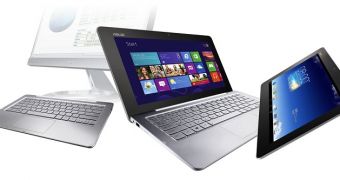ASUS has released its impressive 3-in-1 hybrid Transformer Book Trio across Europe, Japan and Australia. It is now time for the PC manufacturer to introduce the device in its home court, Taiwan.
The company has tweaked the name of the device a little, to mark its introduction on the Taiwanese market, so interested customers will be purchasing the Transformer Book Trio TX201, DigiTimes reports.
We’ve called it a hybrid, but what exactly can this machine do? Well, it can be used in three different modes, as the name itself suggests. First off, there’s the tablet mode, which runs the Android operating system.
It’s extremely lightweight to use as a tablet with its meager 680 g / 1.5 pounds, so customers can very easily carry it around anywhere. When used as a tablet, power is harvested from an Intel Atom Clover Trail+ processor coupled with 2GB of RAM. 16GB of internal storage are provided.
For operations that require the use of a keyboard, like work-related activities, users can plug the keyboard and immediately end up with a laptop. In notebook mode, the Trio runs Windows 8 instead.
As a laptop, the device becomes a little bulkier weighing 1.8 kg / 4 pounds. ASUS has hidden an Intel Haswell processor with 4GB of RAM under the keyboard section, the laptop’s powerhouse. Memory wise, there’s a 500GB HDD on board.
The third mode in which the device can be used is as a desktop. With most convertibles, if you take the keyboard away, you no longer have what to use it for. This case is different, as this particular keyboard can be connected to an external monitor, thus offering a desktop-like experience
The Transformer Trio packs an 11.6-inch screen with a resolution of 1920 x 1080 pixels. Bluetooth, Wi-Fi, USB, audio and video ports are provided, of course.
ASUS has priced the device for the Taiwanese market at $1,353 / €998. Market watchers believe that the price has set a little too far up for the mainstream consumers, so they point out this is ASUS’ way of demonstrating its engineering capabilities and testing the market at the same time.

 14 DAY TRIAL //
14 DAY TRIAL //